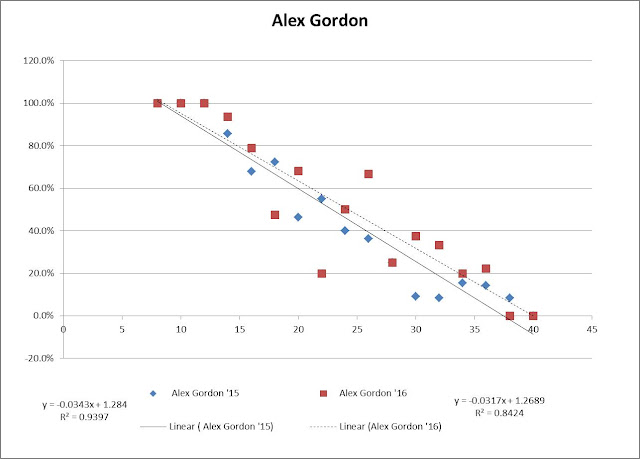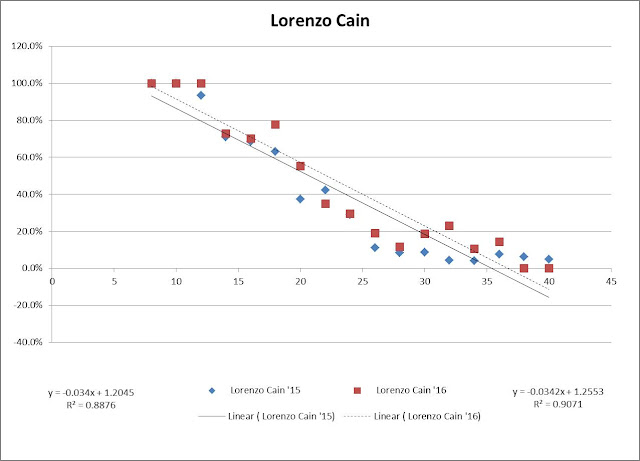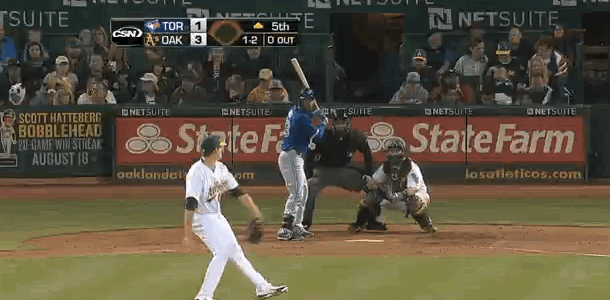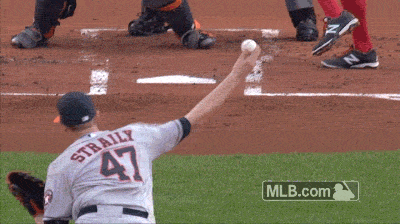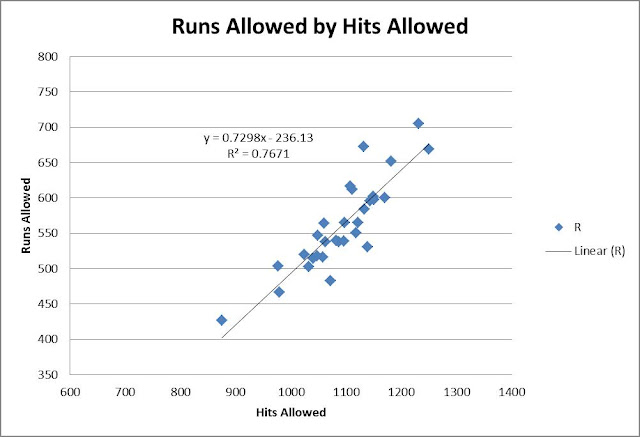Poking Holes In Some of the Best Players of 2016
We are reaching the end of the 2016 fantasy-baseball season, which means two things: 1) It’s time to look ahead to next season a bit, and 2) the sample sizes on many metrics are either stabilized or right around the corner from stabilizing.
With that in mind, let’s take a look at a few of players who are sure to be trendy draft picks in 2017, and see what their potential downfalls might be. This is not to say to avoid these players, but rather to spot a potential weakness so that if you do draft this player, and they start to struggle you can maybe know why, and see if it is a recurring issue, instead of just a bit of bad luck. Let’s meet our contestants:
Rougned Odor
In many ways Rougned Odor has had his coming-out party this season. He has hit 31 home runs through 135 games, adding in 12 steals, to go along with a .282 batting average, and strong production (85 runs and RBI each). He’s been the fifth-best second baseman by the ESPN player rater, and that’s with two players (Daniel Murphy and Jean Segura) with multiple positions above him in the ranks. He even got famous on the national scene with his punch heard round the hot-take tables in May.
However, when looking at his plate discipline, it has somehow got even worse than it was last year. His walk rate has dropped to 3.0 percent (17 walks all season!), while his strikeout rate has climbed above 20 percent (20.9, to be exact). His swing rate on pitches outside the zone is seventh in all of baseball, while his contact on those pitches outside the zone isn’t even in the top 80. That’s a dangerous duo. Talented players who hit the ball as hard as Odor can sustain success while flailing that much for a little while, but in the long haul, it almost always burns you. Odor could certainly make strides to improve his discipline, but coming off the season he is having, why is he going to try to change anything? He may well need a rough season, or at least rough couple of months, to admit he needs to fix the holes in his swing, and you don’t want to deal with that when he does.
Jon Lester
With a record of 16-4 and a 2.51 ERA, Lester is having arguably the best season of his career. He’s a candidate for the Cy Young, and currently trails only Noah Syndergaard and teammate, Kyle Hendricks, in the race for the lowest ERA in all of baseball. There are plenty of signs for regression, though.
For starters, Lester is 32, and while left-handed pitchers seem to age like a fine wine sometimes, that’s only because we forget about the guys who crash and burn and are out of the league by 34. Now Lester is showing no real signs of aging, but he also has signs of regression elsewhere.
His left-on-base rate is currently leading all qualified pitchers, at 85.5 percent. That’s more than 10 percent higher than his career rate, and by far the highest percent of his career. That’s especially amazing considering Lester can’t even throw to first base, meaning runners should be moving around the bases faster on him if anything. He is also one of the FIP-ERA leaders, thanks to a well below-average opponent BABIP (.257).
There’s also the fact that, while not by a huge margin, Lester’s strikeout rate has also dropped this season, while the rest of the league is striking out more batters than ever. If you’re already going to get some regression in terms of ERA and wins, you best not be losing strikeouts, as well.
I don’t think Lester is going to fall off a cliff, but I also don’t think he’ll be repeating his 2016 performance next year.
Michael Fulmer
We’ll start with the most obvious candidate for overdrafting. Fulmer will be a 23-year-old, (likely) coming off an American League Rookie of the Year Award, and pitching for a strong Tigers team. He may well win the AL ERA crown, and will easily have a winning record. Heck, he’s got an outside shot at a Cy Young in what has been a weak year for AL pitchers.
That being said, there are some definite weak spots in his profile, the most obvious being his FIP-ERA. If one were to simply go to the FIP-ERA leaderboard — a good spot to at least start to find potential regression candidates — Fulmer’s name is sitting there in fourth, trailing only Kyle Hendricks (borderline historic ERA), Brandon Finnegan (a guy who would have certainly made this list if he were famous enough), and Ian Kennedy (a professor at Hogwarts in the baseball offseason).
It’s more than just the FIP with Fulmer, though. His left-on-base rate is over 80 percent (81.3, to be exact), and his opponent BABIP is just .251. He allows over 30 percent hard-hit rate and his line-drive rate allowed is nearly 20 percent, which while not terrible, do not portend a Cy Young winner.
With Fulmer, it’s more an accumulation of slights rather than one big one, combined with the fact that he will be an extremely trendy pick. There’s no reason to believe he won’t finish the year 13-8 with a 3.35 ERA and 140 strikeouts, but you’ll have to pay for much better stats than that to land him.
Ryan Braun
Like all of the players on this list, Braun is having one of his best seasons in 2016, which is saying something for the six-time All-Star. Braun is hitting .310 with 27 home runs, both of which are his highest since 2012. He has also stolen 14 bases, and only been caught three times, impressive for a 32-year-old.
But it’s not Braun’s age that is troubling (although it is obviously worth remembering come draft day); it’s his ground-ball rate. Braun is seventh in all of baseball in ground-ball rate, surrounded by names like Jonathan Villar and Cesar Hernandez. He has hit ground balls on 55.6 percent of the balls he has put in play in 2016, and has only hit fly balls on 25.4 percent. Because of that, it’s hard to imagine his home-run totals staying as high as they are right now in 2017.
Braun is currently sporting a HR/FB rate of 28.4 percent, highest in the major leagues. Ask Jose Abreu owners what it is like to own the reigning HR/FB rate champion. Here’s how the last four HR/FB rate champions fared the next season:
2012 Adam Dunn – 41 HRs; 2013 Adam Dunn – 34 HRs
2013 Chris Davis – 53 HRs; 2014 Chris Davis – 26 HRs
2014 Jose Abreu – 36 HRs; 2015 Jose Abreu – 30 HRs
2015 Nelson Cruz 44 HRs; 2016 Nelson Cruz 35 HRs (with 18 games to go)
Only Chris Davis fell off the earth, but none of the four went up. If you’re buying on Braun’s power, you’re basically buying at its highest point, which is never a good idea. Especially with a 32-year-old.
Jose Fernandez
Yes, we are getting a little bit into “snake eating his own tail,” by turning advanced metrics against Jose Fernandez, after spending all of the first couple months using the advanced numbers to show a turnaround was imminent, but it was foolish to ignore Fernandez’s biggest weakness: his line-drive rate allowed.
Opponents are hitting line drives off Fernandez 29.3 percent of the time in 2016, by far the highest percent among qualified pitchers, and a rate that tops even Freddie Freeman, the 2016 league-leader in line-drive rate.
Part of that can be explained by the fact that Fernandez throws so hard, that of course the ball is going to come out faster — that’s just physics. It also isn’t as big a deal to allow such a high line-drive rate, when you also have, by far, the highest strikeout rate in the big leagues this season (34.9 percent). It doesn’t matter how hard you hit it, if you simply can’t hit it.
However, that line-drive rate certainly helps to explain the fact that opponents have a BABIP of .341 off Fernandez this year, a figure that would seem due for some regression in favor of Fernandez if we missed looking at the full picture. Some 2017 drafters may see Fernandez’s .341 BABIP and his 2.27 FIP and assume that his 2017 ERA will drop into the low 2.00s. If Fernandez keeps allowing line drives at the rate he has this season, there’s no reason to think his ERA will drop at all. Now drafting a player with an ERA of 3.00 and the best strikeout rate in baseball is still never a bad idea, but if batters start to elevate their swings against Fernandez, while maintaining that same hard contact, Jose could see his home-run rate jump up quite a bit, even when pitching in pitcher-friendly Marlins Park.
Fernandez allowed just as high a line-drive rate in his 11 starts in 2015, and while some of it may still be noise, it is something to keep an eye on. Especially if you have Fernandez in a long-term keeper league, and he eventually makes a move to somewhere like Fenway where the stadium might be a lot less forgiving than in Miami.




